Judi Lynn
Judi Lynn's JournalThe Biggest Human-Made Pyramid On Earth Isn't In Egypt
The Great Pyramid of Cholula is 2,000 years old.
RACHAEL FUNNELL
Social Editor and Staff Writer
Sep 16, 2022 9:34 AM
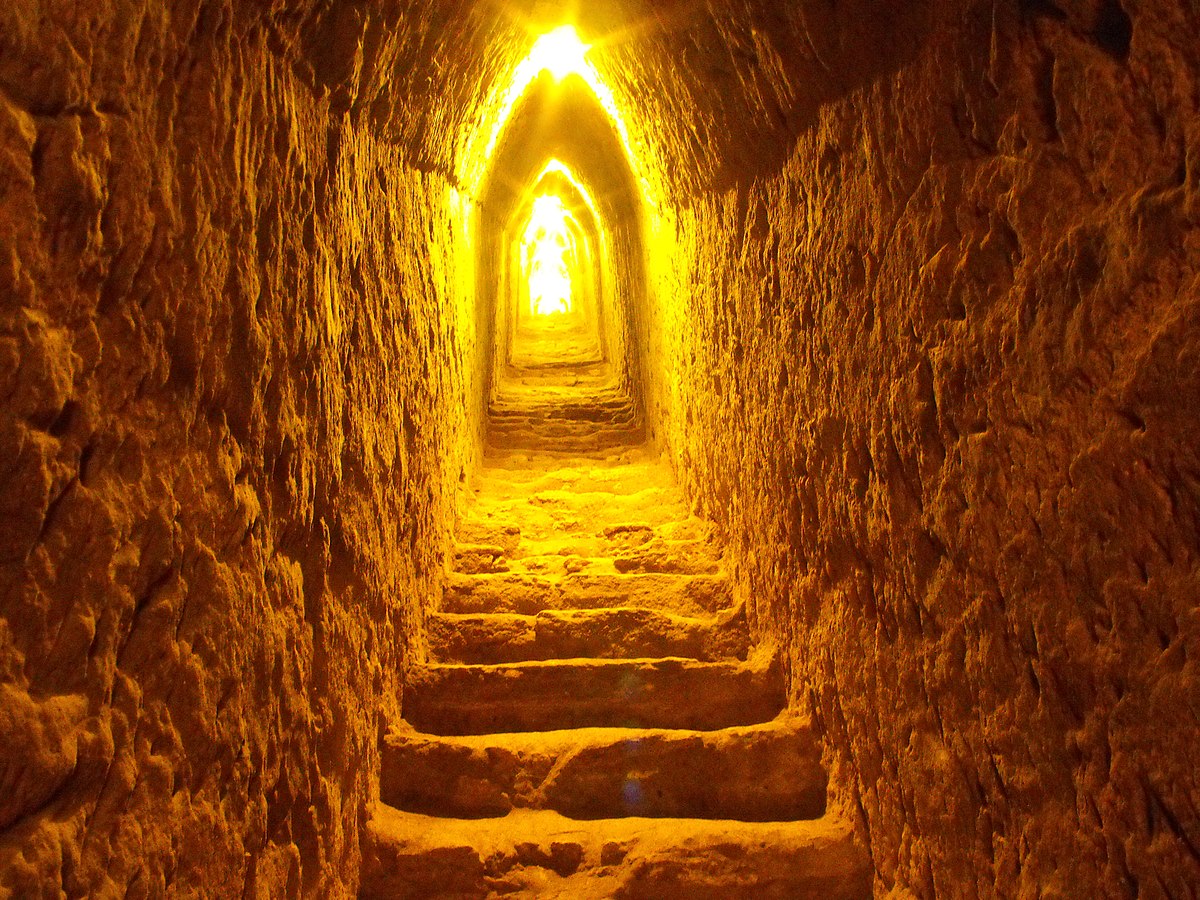
cholula pyramid
Image credit: diego_cue,CC BY-SA 3.0
In Mexico sits the Great Pyramid of Cholula, also known as the Great Pyramid of Tepanapa, a 2,000-year-old human-made structure that went completely unnoticed by the Spanish army when they invaded in 1519. An impressive oversight when you consider that it’s the biggest pyramid on Earth. How did they miss it? Quite simply, it’s hidden inside a hill.
The Cholula Massacre was one of the most infamous endeavors of conquistador Hernán Cortés who stormed the city of Cholula on October 12, 1519. Cortés’s army arrived anticipating a fight but were met with a sacred city believed to be home to a holy pyramid for every day of the year; structures built to place divine protection over the city.
Instead, as the lives of 3,000 people were taken (amounting to 10 percent of the city’s population) the many pyramids became the subjects of looting. Having claimed the many religious artifacts, the Spanish settled in Cholula and began erecting their own churches.
One of those, the Iglesia de Nuestra Señora de los Remediosa, was to become – effectively – a hat, after it was unknowingly placed on top of the Great Pyramid of Cholula. At 66 meters (216 feet) tall and 450 meters (1,475 feet) wide, it’s the largest pyramidin the world, with a volume that’s nearly twice that of the Great Pyramid of Giza.

cholula pyramid
When the Spanish invasion happened, nobody knew the world's biggest pyramid was sitting beneath a hill. Image credit: Janice Waltzer, CC BY 2.0, via Wikimedia Commons
More:
https://www.iflscience.com/the-biggest-human-made-pyramid-on-earth-isn-t-in-egypt-65328
~ ~ ~
The Largest Pyramid in the World
Hidden beneath a hill in Cholula, Mexico lies the largest pyramid ever built.
Dean Nicholas | Published in History Today Volume 66 Issue 8 August 2016
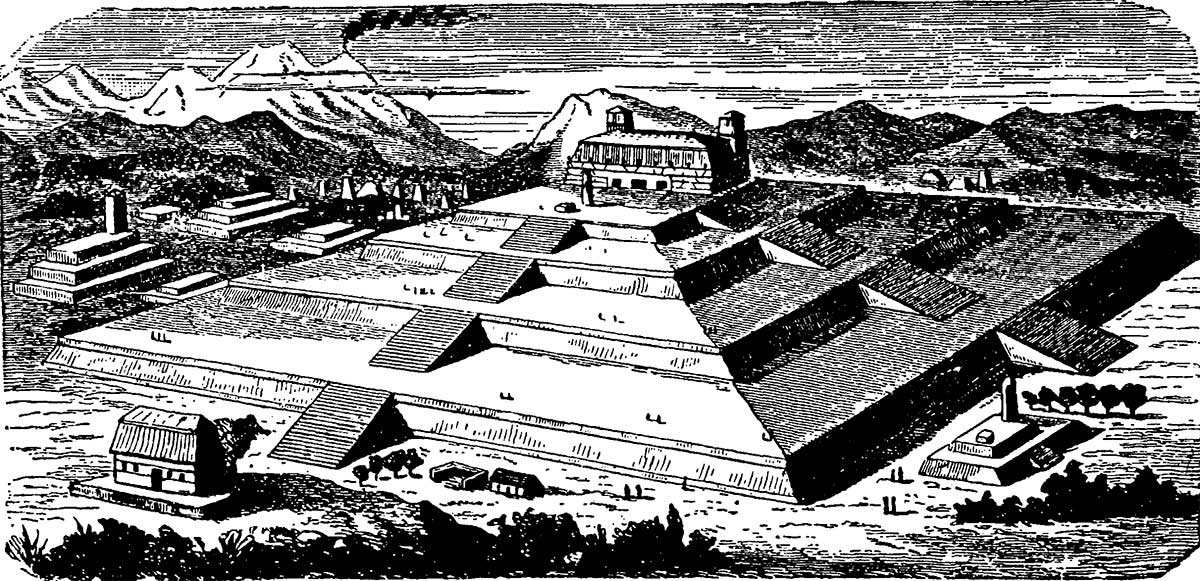
The world’s largest pyramid can be found not in Egypt, but hidden beneath a hill in a small town in the central Mexican state of Puebla. Known variously as the Great Pyramid of Cholula, Pirámide Tepanapa, or, in the indigenous Nahuatl language, Tlachihualtepetl, or ‘artificial mountain’, the structure measures 400 by 400 metres and has a total volume of 4.45 million cubic metres, almost twice that of the Great Pyramid of Giza. It was first constructed around 200 BC and expanded or rebuilt several times over the following centuries by different civilisations, including the Olmecs and the Toltecs. According to Aztec mythology, it was built by Xelhua, a giant whose edifice so upset the gods that they hurled fire down upon it.
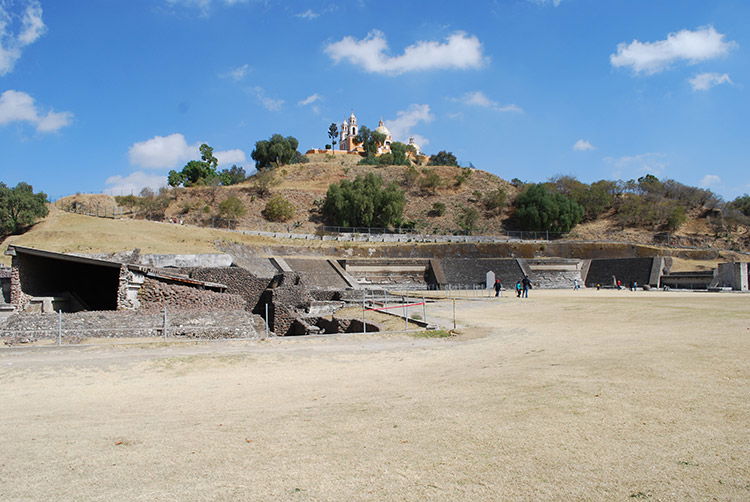
Excavated part of the pyramid
At its height over 100,000 people lived around the pyramid, although by the time the Spanish arrived in 1520 it had become covered by dirt and was hidden from view, with newer temples constructed on its outskirts. Hernán Cortés and his men slaughtered many of the Cholulans, probably to scare the inhabitants of the nearby Aztec capital Tenochtitlan into submission, but, to judge by the church they built on top (still standing today), the Spanish were clearly unaware of the hill’s true nature. The pyramid was re-discovered in the late 19th century and since then archaeologists have begun to excavate the network of tunnels that run through its base.
https://www.historytoday.com/grand-tour/largest-pyramid-world
In Brazil, Marielle Franco's memory inspires the Black, feminist, LGBTQ+ cause against the extreme r
In Brazil, Marielle Franco’s memory inspires the Black, feminist, LGBTQ+ cause against the extreme right
Published: Nov. 29, 2022, 4:41 p.m.
By Palabra
Editor’s note: This story first appeared on palabra, the digital news site by the National Association of Hispanic Journalists.
By Témoris Grecko
Francia Márquez invited Anielle Franco to join her on stage at Auditorio Mayor in the Colombian capital of Bogotá. It was March 5, 2022, and Márquez was still a promising presidential candidate, but not yet victorious. However, her followers, like Anielle, felt she was already Colombia’s first female and Black president. Anielle had come all the way from Rio de Janeiro, in neighboring Brazil, to witness her campaign’s closing rally ahead of the primary election that would determine the presidential candidate from Colombia’s leftist coalition, Pacto Histórico. Weeks later, Márquez instead became front-runner, Gustavo Petro’s, running mate. And on June 19, she was elected vice president.
Francia waved a yellow scarf that read “Justiça por Marielle” in Portuguese and displayed the face of a Black woman in high-contrast. The Afro-Colombian politician was one of those demanding justice for Anielle’s sister, Marielle Franco, who had been murdered in Rio four years earlier, on March 14, 2018. Anielle saw similarities between the two women: like Márquez, Marielle Franco was a Black, single mother who had dared to venture into White, male-dominated politics, under a far-right government with misogynistic, racist, violent tendencies, openly inspired by Donald Trump’s tactics.
. . .
Stigmas for the struggle
“I am because we are” (eu sou porque nós somos): This was Marielle’s leitmotif and it appears on her memorial wall, located a few feet away on Joaquim Palhares Avenue in downtown Rio, where the city council member was killed. The day she was murdered, she was on her way home after meeting with local women. At about 11 p.m., the assassins pulled up next to Marielle’s car and fired thirteen shots. She took a bullet to the neck and three to the head. Her driver, Anderson Gomes, was shot three times. An aid sitting with Marielle in the back seat was wounded by shrapnel.
. . .
Marielle’s most noteworthy line of work was denouncing the violence of milícias, right-wing paramilitary groups formed by current or former police officers, who claim they are fighting drug-trafficking gangs only to take over their business. They impose their bloody rule over the favelados with racketeering, kidnappings, torture, and killings. Nevertheless, politicians, police officers, some press, prosecutors, and even judges pretend to believe the milicias’ goals are fair to justify leniency and blatant complicity.
More:
https://www.cleveland.com/palabra/2022/11/in-brazil-marielle-francos-memory-inspires-the-black-feminist-lgbtq-cause-against-the-extreme-right.html
The frog that could save the world: Colombia's Starry Night Toad
9 Nov 2022
Thought to be extinct for 30 years, the starry night harlequin toad is thriving in Colombia due to the local way of life.
In Colombia, Arhuaco leader Ruperto Chaparro Villafaña teams up with scientists to save the critically endangered starry night harlequin toad.
They need to unite both indigenous and western scientific knowledge to understand the role of the toads in the unique ecosystem of the Sierra Nevada de Santa Marta, the world’s highest coastal mountain and the sacred land of the Arhuacos.
The life cycle of the frog helps determine when to cultivate and harvest different crops – the reason this species is a bellwether for their community-based project.
Chaparro Villafaña must also defend their territory against illegal land grabbers, even as he is working with scientists to find the cure for a deadly fungus that threatens all harlequin toad species in the Central, South and North America.
https://www.aljazeera.com/program/first-nations-frontline/2022/11/9/the-frog-that-could-save-the-world-colombias-starry-night-toad
The Hero in the Labyrinth The Pioneering Work of Joseph Campbell
Ancient stories or those collected by ethnographers; fairy tales, folk tales, and legends from across the globe; the Old Testament as well as Aztec, Egyptian, and Indian myths; The Grimm Fairy Tales and One Thousand and One Nights. Joseph Campbell searched all of the above for hidden patterns, timeless and spaceless forms of the human imagination. He developed the idea of the spiritual unity of human beings when he discovered the existence of universal motifs and topics, such as the virgin birth, the journey into the afterlife, sacrificing kings, and the resurrection of a deity. As James Hillman aptly pointed out, Campbell belonged to a generation of intellectuals born shortly before World War I whose works were created under the influence of 19th-century models of scholarship. The American’s incredible erudition and diligence stemmed from his ambition to create a total synthesis of human spiritual life.
His fascination with Indigenous American mythologies was inspired by the childhood books his parents bought him. He was first and foremost a reader, up until old age. When Alan Watts once asked what type of yoga he practiced, Campbell allegedly replied that his was the yoga of “emphasizing sentences.” Jean Erdman, an avant-garde theater director and dancer (Campbell’s wife of nearly fifty years who died in 2020 at the age of 104), recalled that during one of their first walks in Manhattan, Campbell lent her Oswald Spengler’s The Decline of the West. Suddenly it started pouring. The young man immediately took off his coat, and she assumed he meant to romantically shield her from the rain. Soon enough she realized he was more interested in protecting the book than her.
However, his adoration for books and his incredible erudition weren’t an obstacle to the other activities he undertook. Campbell abandoned his academic career when he became convinced that teaching others about finding life truths in books was a naive way of deceiving both his students and himself. He learned surfing from the one and only Duke Kahanamoku. He played the saxophone in a jazz band. He was an athlete and a sportsman—he almost qualified for the US national track and field team (not making it to the Olympics was purportedly his life-long regret). He constantly traveled between Europe and America, which resulted in peculiar meetings. He met Jidda Krishnamurti on a steamer in 1924, and the philosopher’s secretary gave Campbell his first book about the Buddha—Edwin Arnold’s The Light of Asia. Thanks to this friendship, later strengthened in the Dutch Castle Eerde where Krishnamurti’s organization was headquartered, Campbell was introduced to the “miraculous world of India’s spiritual culture.”
At the turn of the 1930s he studied medieval literature at the Sorbonne (mostly tales about the quest for the Holy Grail) and enjoyed the aura of bohemian Paris. He then moved to Germany to study Sanskrit. His first book was an analysis of James Joyce’s Finnegans Wake. His other great literary fascination was Thomas Mann, whom he met and with whom he corresponded.
. . .
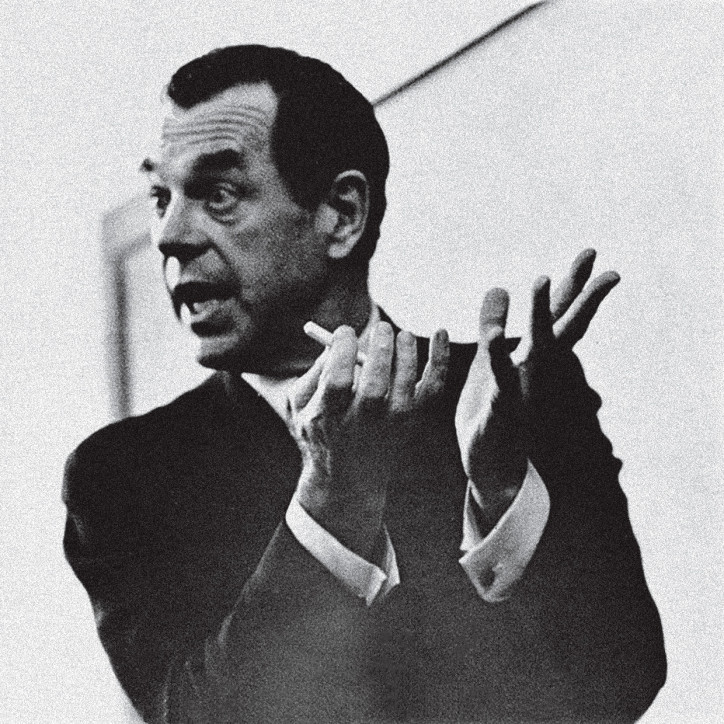
Joseph Campbell. Photo courtesy of the Joseph Campbell Foundation (jcf.org)
More:
https://przekroj.pl/en/society/the-hero-in-the-labyrinth-tomasz-wisniewski
These 84-Year-Old Nazi Photos Paint a Harrowing Picture of Kristallnacht
The images show mobs ransacking Jewish-owned homes, businesses and synagogues in 1938
Sarah Kuta
Daily Correspondent
November 15, 2022

Synagogue on fire
Nazis set an estimated 1,400 synagogues on fire during Kristallnacht. Courtesy of Yad Vashem Photo Archive
On November 9 and 10, 1938, Nazis wreaked havoc on thousands of Jewish-owned businesses, homes and synagogues throughout Germany and Austria. Mobs attacked Jewish families, looted and vandalized shops and torched buildings. Some 30,000 Jewish men were rounded up and sent to concentration camps.
In the end, more than 90 Jews were killed during the pogroms, which took place nearly a year before the start of World War II and became known as Kristallnacht, or the “Night of Broken Glass.”
Last week, Yad Vashem, Israel’s Holocaust memorial museum, shared a series of striking photos from the attacks, bringing renewed awareness to the horrific massacre in remembrance of its 84th anniversary.
Nazi photographers captured the harrowing images during the pogroms in Nuremberg and nearby Fuerth. Some of the photos show the Nazis in the midst of their destruction—ripping couch cushions apart, violently yanking books off of shelves. Others show Jews standing in their pajamas, sometimes with blood on their clothes and bodies.
More:
https://www.smithsonianmag.com/smart-news/84-year-old-nazi-photos-paint-a-harrowing-picture-of-kristallnacht-180981123/
Cool leaf! Study records chimp showing off object in human-like way
Adult ape sharing information and just wanted mother to look at foliage with no motive otherwise, scientists say
Nicola Davis Science correspondent
@NicolaKSDavis
Mon 14 Nov 2022 15.00 EST
Chimpanzees show each other objects just for the sake of it, researchers have found, revealing it isn’t only humans who like to draw attention to items that have captured their interest.
As anyone who has spent time with a child knows, even very young humans like to point out objects to others. However, it was previously thought this behaviour only occurs in our species.
Now researchers say they have found an instance of a chimpanzee showing her mother a leaf.
“She’s not offering it for food. She doesn’t want her mum to do anything. She just wants them to look at it together, and be like ‘Oh, cool, nice!’,” said Prof Katie Slocombe of the University of York, a co-author of the study.
More:
https://www.theguardian.com/science/2022/nov/14/cool-leaf-study-records-chimp-showing-off-object-in-human-like-way
Largest known manta ray population is thriving off the coast of Ecuador, new research shows
NOVEMBER 14, 2022
by Michelle Klampe, Oregon State University
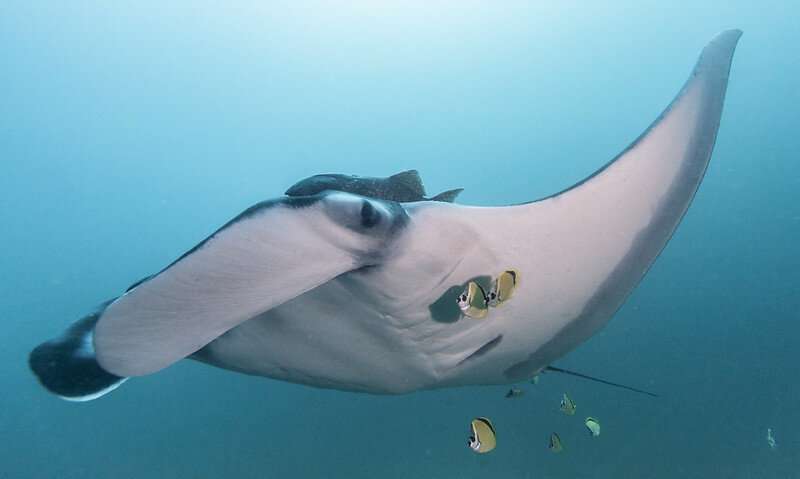
A manta ray near Isla de la Plata off the coast of Ecuador. Credit: Fundacion Megafauna Marina del Ecuador
Scientists have identified off the coast of Ecuador a distinct population of oceanic manta rays that is more than 10 times larger than any other known subpopulation of the species.
The findings, just reported in the journal Marine Ecology Progress Series, indicate that while other populations of oceanic manta rays are typically small and vulnerable to human impacts, this population is large and potentially quite healthy, said Joshua Stewart, an assistant professor with the Marine Mammal Institute in OSU's College of Agricultural Sciences and a co-author of the paper.
"It's clear that something different is happening here," Stewart said. "This is a rare story of ocean optimism. In other regions, we typically have population estimates of 1,000 to 2,000 animals, which makes this species very vulnerable. In this area, we've estimated that the population is more than 22,000 mantas, which is unprecedented."
Oceanic manta rays are the largest species of ray, with wingspans that can reach more than 20 feet. They are filter feeders that eat large quantities of krill and other zooplankton and tend to live in small subpopulations in tropical, subtropical and temperate waters, spending much of their time in the open ocean.
Oceanic manta rays were listed as threatened under the U.S. Endangered Species Act in 2018, and in 2019 their threat category increased from vulnerable to endangered on the International Union for the Conservation of Nature's Red List. The biggest threat to oceanic manta rays is commercial fishing, both as the target of some fisheries and as unintentional bycatch in many others.
More:
https://phys.org/news/2022-11-largest-manta-ray-population-coast.html
Money Launderers In Honduras Are Getting Away With It
Rohan Parakkad / Nov 08 2022, 09:36AM EST
Dozens of individuals with claimed ties to organized crime have been released a year after Honduras changed its money laundering law, and there is a growing belief that this is an effort to shield those in authority.
According to a report by Insight Crime, at least 45 people with connections to organized crime have been released in the past year after their cases were dismissed as a result of a controversial reform to Honduras' Special Law Against Asset Laundering. The Honduran government published legal changes to the law in its official gazette last year after congress approved the reform.
These changes meant that proving someone had unexplained wealth was no longer enough to charge them with money laundering. Prosecutors must instead prove a link between the suspect's assets and another crime, like the distribution of drugs or the sale of weapons. Additionally, unless with a judge's prior approval, investigators are no longer permitted to access a suspect's or a company's financial records.
. . .
The decision to make it harder to prosecute money launderers seems suspicious in a nation where a previous president was extradited to the US on drug trafficking charges.
. . .
In 2019 the Honduran congress passed a controversial law that was criticized for protecting politicians from being investigated for embezzlement of public funds.
More:
https://www.latintimes.com/money-launderers-honduras-are-getting-away-it-531772
Colombia, Venezuela pledge to save Amazon rainforest
Gustavo Petro and Nicolas Maduro launch call at COP27 climate summit for wide-ranging alliance to protect planet’s biggest tropical forest
Laura Gamba |
09.11.2022
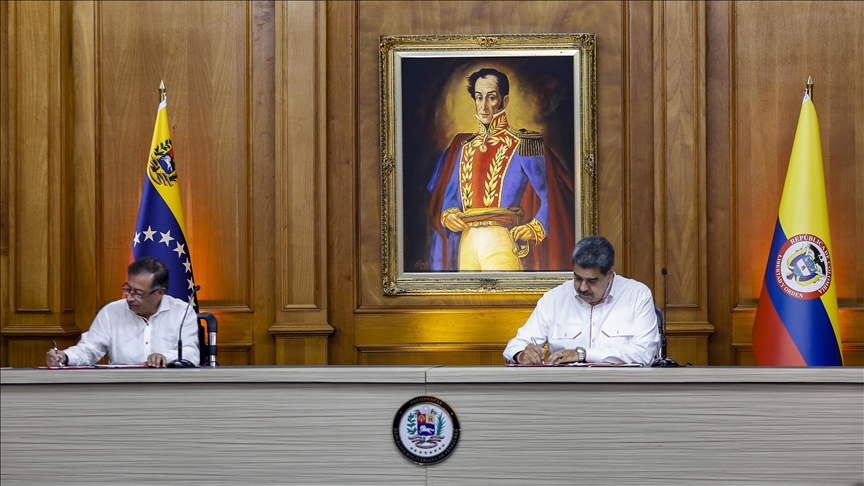
BOGOTA, Colombia
The presidents of Colombia and Venezuela, Gustavo Petro and Nicolas Maduro, issued a call Tuesday at the COP27 climate summit for forming an alliance to protect the Amazon, the planet's biggest tropical forest.
"We are determined to revitalize the Amazon rainforest to give humanity an important victory in the fight against climate change," Petro said at the UN climate summit, which is being held in the Egyptian resort city of Sharm el-Sheikh.
"If we, in the South Americas, carry a responsibility, it is to stop the destruction of the Amazon and put in place a coordinated process of recovery," Maduro said at the summit as he spoke next to Petro.
Petro called for the involvement of the United States, "the country that pollutes the most" on the American continent, while the south of the landmass is "the sponge that absorbs the most CO2."
He said his country will allocate $200 million a year over the next two decades to save the Amazon and appealed for the solidarity of multilateral organizations and big countries in the world.
More:
https://www.aa.com.tr/en/americas/colombia-venezuela-pledge-to-save-amazon-rainforest/2733115
Ichkabal archaeological site near Bacalar will soon open to the public

Ichkabal was rediscovered by researchers in 1994. INAH
The site is home to a pyramid twice the size of the large Kukulkán temple in Chichén-Itzá
Published on Monday, November 7, 2022
On route to the Bacalar lagoon in Mexico’s Yucatán Peninsula, the site of the ancient Maya city of Ichkabal (City of Snakes) will soon open to visitors, according to Diego Prieto Hernández, Director of the National Institute of Anthropology and History (INAH).
. . .
With a large portion of the city still lying beneath the jungle, the site is currently being excavated by the National Institute of Archaeology and History (INAH) as part of the Program for the Improvement of Archeological Sites (Promeza), an initiative to improve and/or develop archaeological sites along the route of the under-construction Maya Train, a commuter and tourist railroad route that will have stops near many tourist cities and attractions in southern Mexico.
. . .
So far, excavation at Ichkabal has revealed a central set of five buildings that are at least 2,400 years old. Standing out among them is a 40-meter-high pyramid twice the size of the large Kukulkán temple in Chichén Itzá. The Ichkabal pyramid has a base area similar to that of the Pyramid of the Sun in Teotihuacán.
The artificial lagoons used as water reservoirs for the ancient city have also surprised archaeologists. In an interview with the newspaper La Jornada, INAH archeologist Sandra Balanzario said that the lagoons used an advanced hydraulic technique to avoid erosion and water seepage, allowing the lagoons to support the daily life of a city of 100,000 inhabitants spread over an area of 60 square kilometers.
More:
https://mexiconewsdaily.com/culture/ichkabal-site-soon-open/
Profile Information
Member since: 2002Number of posts: 160,638